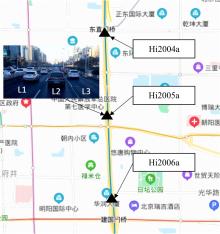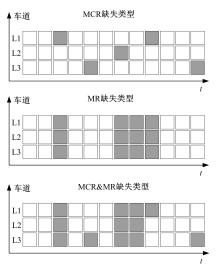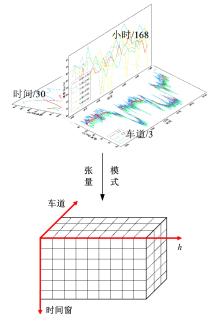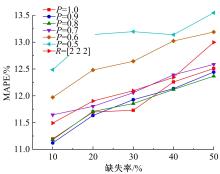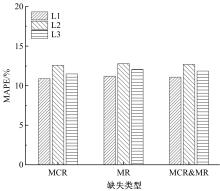Journal of Jilin University(Engineering and Technology Edition) ›› 2021, Vol. 51 ›› Issue (5): 1708-1715.doi: 10.13229/j.cnki.jdxbgxb20200535
Data imputation approach for lane⁃scale traffic flow based on tensor decomposition theory
Wen-qi LU1( ),Tian ZHOU2,Yuan-li GU2,Yi-kang RUI1(
),Tian ZHOU2,Yuan-li GU2,Yi-kang RUI1( ),Bin RAN1
),Bin RAN1
- 1.School of Transportation,Southeast University,Nanjing 211189,China
2.Key Laboratory of Transport Industry of Big Data Application Technologies for Comprehensive Transport,Ministry of Transport,Beijing Jiaotong University,Beijing 100044,China
CLC Number:
- U491
| 1 | Raza A, Zhong M. Hybrid artificial neural network and locally weighted regression models for lane-based short-term urban traffic flow forecasting[J]. Transportation Planning and Technology, 2018, 41(8): 901-917. |
| 2 | Gu Y L, Lu W Q, Qin L Q, et al. Short-term prediction of lane-level traffic speeds: a fusion deep learning model[J]. Transportation Research Part C: Emerging Technologies, 2019, 106: 1-16. |
| 3 | Lu W Q, Rui Y K, Yi Z W, et al. A hybrid model for lane-level traffic flow forecasting based on complete ensemble empirical mode decomposition and extreme gradient boosting[J]. IEEE Access, 2020, 8: 42042-42054. |
| 4 | Zhong M, Sharma S, Lingras P. Genetically designed models for accurate imputation of missing traffic counts[J]. Transportation Research Record, 2004(1879): 71-79. |
| 5 | Williams B M, Hoel L A. Modeling and forecasting vehicular traffic flow as a seasonal ARIMA process: Theoretical basis and empirical results[J]. Journal of Transportation Engineering, 2003, 129(6): 664-672. |
| 6 | Bermúdez J D, Corberán-Vallet A, Vercher E. Forecasting time series with missing data using Holt's model[J]. Journal of Statistical Planning & Inference, 2009, 139(8): 2791-2799. |
| 7 | 王新颖, 隽志才, 吴庆妍, 等. KNN算法的数据优化策略[J]. 吉林大学学报: 信息科学版, 2010, 28(3): 309-313. |
| Wang Xin-ying, Zhi-cai Juan, Wu Qing-yan, et al. Data optimization strategy of KNN algorithm[J]. Journal of Jilin University(Information Science Edition), 2010, 28(3): 309-313. | |
| 8 | 陈亮, 王金泓, 何涛, 等. 基于SVR的区域交通碳排放预测研究[J]. 交通运输系统工程与信息, 2018, 18(2): 13-19. |
| Chen Liang, Wang Jing-hong, He Tao, et al. Forecast study of regional transportation carbon emissions based on SVR[J]. Journal of Transportation Systems Engineering and Information Technology, 2018, 18(2): 13-19. | |
| 9 | Qu L, Zhang Y, Hu J M, et al. A BPCA based missing value imputing method for traffic flow volume data[J]. IEEE Intelligent Vehicles Symposium, 2008: 985-990. |
| 10 | Qu L, Li L, Zhang Y, et al. PPCA-based missing data imputation for traffic flow volume: a systematical approach[J]. IEEE Transactions on Intelligent Transportation Systems, 2009, 10(3): 512-522. |
| 11 | Acar E, Dunlavy D M, Kolda T G, et al. Scalable tensor factorizations for incomplete data[J]. Chemometrics and Intelligent Laboratory Systems, 2011, 106(1): 41-56. |
| 12 | Tan H C, Feng G D, Feng J S, et al. A tensor-based method for missing traffic data completion[J]. Transportation Research Part C: Emerging Technologies, 2013, 28: 15-27. |
| 13 | Kolda T G, Bader B W. Tensor decompositions and applications[J]. SIAM review, 2009, 51(3): 455-500. |
| 14 | de Lathauwer L, de Moor B, Vandewalle J. A Multilinear singular value decomposition[J]. SIAM Journal on Matrix Analysis and Applications, 2000, 21(4):1253-1278. |
| 15 | Chen X Y, He Z C, Wang J W. Spatial-temporal traffic speed patterns discovery and incomplete data recovery via SVD-combined tensor decomposition[J]. Transportation Research Part C: Emerging Technologies, 2018, 86: 59-77. |
| 16 | Polyak B T. Some methods of speeding up the convergence of iteration methods[J]. USSR Computational Mathematics and Mathematical Physics, 1964, 4(5): 1-17. |
| 17 | Li L C, Du B W, Wang Y G, et al. Estimation of missing values in heterogeneous traffic data: application of multimodal deep learning model[J]. Knowledge-Based Systems, 2020, 194: 105592. |
| 18 | Chen X Y, He Z C, Sun L J. A bayesian tensor decomposition approach for spatiotemporal traffic data imputation[J]. Transportation Research Part C: Emerging Technologies, 2018, 98: 73-84. |
| 19 | 谷远利, 张源, 芮小平, 等. 基于免疫算法优化LSSVM的短时交通流预测[J]. 吉林大学学报: 工学版, 2019, 49(6): 1852-1857. |
| Gu Yuan-li, Zhang Yuan, Rui Xiao-ping, et al. Short-term traffic flow prediction based on LSSVM optimized by immune algorithm[J]. Journal of Jilin University(Engineering and Technology Edition), 2019, 49(6): 1852-1857. | |
| 20 | 杨飞, 方滨兴, 王春露, 等. 基于小波和回声状态网络的交通流多步预测模型[J]. 吉林大学学报: 工学版, 2013, 43(3): 646-653. |
| Yang Fei, Fang Bin-xing, Wang Chun-lu, et al. Multi-step traffic flow prediction model based on wavelet and echo state network[J]. Journal of Jilin University(Engineering and Technology Edition), 2013, 43(3): 646-653. | |
| 21 | 龚勃文, 林赐云, 李静, 等. 基于核自组织映射-前馈神经网络的交通流短时预测[J]. 吉林大学学报: 工学版, 2011, 41(4): 938-943. |
| Gong Bo-wen, Lin Xi-yun, Li Jing, et al. Short-term traffic flow prediction based on KSOM BP neural network[J]. Journal of Jilin University(Engineering and Technology Edition), 2011, 41(4): 938-943. |
| [1] | Hao LI,Hao CHEN. Mixed traffic network equilibrium with battery electric vehicles considering charging queuing time [J]. Journal of Jilin University(Engineering and Technology Edition), 2021, 51(5): 1684-1691. |
| [2] | Ying-ying MA,Si-yuan LU,Xiao-ming ZHANG,Wen-shu WEI. Model of highway travel selection considering individual risk preference difference [J]. Journal of Jilin University(Engineering and Technology Edition), 2021, 51(5): 1673-1683. |
| [3] | Rong-han YAO,Wen-yan QI,Liu-jie ZHENG,Da-yi QU. Settings of guiding markings for left⁃turning vehicles based on lane selection and vehicle trajectory [J]. Journal of Jilin University(Engineering and Technology Edition), 2021, 51(5): 1651-1663. |
| [4] | Li-sheng JIN,Bai-cang GUO,Fang-rong WANG,Jian SHI. Dynamic multiple object detection algorithm for vehicle forward based on improved YOLOv3 [J]. Journal of Jilin University(Engineering and Technology Edition), 2021, 51(4): 1427-1436. |
| [5] | Jin XU,Cun-shu PAN,Jing-hou FU,Jun LIU,Dan-qi WANG. Speed behavior characteristic on typical driving scenarios and along switched scenarios [J]. Journal of Jilin University(Engineering and Technology Edition), 2021, 51(4): 1331-1341. |
| [6] | Kai LU,Wei WU,Guan-rong LIN,Xin TIAN,Jian-min XU. Combination forecasting model for number of assembling passengers at transportation terminal based on KNN regression algorithm [J]. Journal of Jilin University(Engineering and Technology Edition), 2021, 51(4): 1241-1250. |
| [7] | Bo PENG,Yuan-yuan ZHANG,Yu-ting WANG,Ju TANG,Ji-ming XIE. Automatic traffic state recognition from videos based on auto⁃encoder and classifiers [J]. Journal of Jilin University(Engineering and Technology Edition), 2021, 51(3): 886-892. |
| [8] | Guo-zhu CHENG,Rui CHENG,Liang XU,Wen-hui ZHANG. Risk assessment of roadside accidents based on occupant injuries analysis [J]. Journal of Jilin University(Engineering and Technology Edition), 2021, 51(3): 875-885. |
| [9] | Ren HE,Xiao-cong ZHAO,Yi-bin YANG,Jian-qiang WANG. Man⁃machine shared driving model using risk⁃response mechanism of human driver [J]. Journal of Jilin University(Engineering and Technology Edition), 2021, 51(3): 799-809. |
| [10] | Wei-xiong ZHA,Qi-yan CAI,Jian LI,Li-xin YAN. Optimization of offset of urban arterial signal coordination under condition of vehicle entry and exit on side road [J]. Journal of Jilin University(Engineering and Technology Edition), 2021, 51(2): 565-574. |
| [11] | Jian ZHANG,Kun-run WU,Min YANG,Bin RAN. Double⁃ring adaptive control model of intersection during intelligent and connected environment [J]. Journal of Jilin University(Engineering and Technology Edition), 2021, 51(2): 541-548. |
| [12] | Cai-hua ZHU,Xiao-li SUN,Yan LI. Forecast of urban public bicycle traffic demand by station classification [J]. Journal of Jilin University(Engineering and Technology Edition), 2021, 51(2): 531-540. |
| [13] | Dian-hai WANG,Xin-yi SHEN,Xiao-qin LUO,Sheng JIN. Offset optimization with minimum average vehicle delay [J]. Journal of Jilin University(Engineering and Technology Edition), 2021, 51(2): 511-523. |
| [14] | Wen-hui ZHANG,Jia-qi QIN,Hong-tao LI,Hong-xing DENG,Guo-zhu CHENG. Travel choice model between bus transit and subway considering crowding degree [J]. Journal of Jilin University(Engineering and Technology Edition), 2021, 51(1): 200-205. |
| [15] | Xian-min SONG,Ming-ye ZHANG,Zhen-jian LI,Xin WANG,Ya-nan ZHANG. Setting of dynamic bus lane and its simulation analysis and evaluation [J]. Journal of Jilin University(Engineering and Technology Edition), 2020, 50(5): 1677-1686. |
|
||


